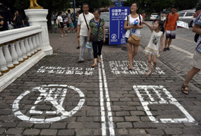 Opps! What a coincidence!
Opps! What a coincidence!
 Breathtaking scenery in Redstone Park in SW China
Breathtaking scenery in Redstone Park in SW China
 Vintage cars show kicks off in London
Vintage cars show kicks off in London
 Gorgeous scenery in NE China
Gorgeous scenery in NE China
 Picturesque Barkol grassland in Xinjiang
Picturesque Barkol grassland in Xinjiang
 Small Wild Goose Pagoda - A World Cultural Heritage Site along the Silk Road
Small Wild Goose Pagoda - A World Cultural Heritage Site along the Silk Road
 Maritime Silk Road Luxuries of the Han Dynasty
Maritime Silk Road Luxuries of the Han Dynasty
 Ciao! Chinese beauties!
Ciao! Chinese beauties!
 An eye feast: BFA freshmen registration
An eye feast: BFA freshmen registration
 Top 10 most lavish weddings
Top 10 most lavish weddings
III. Development and Construction
The economic development of the XPCC is an important part of the comprehensive economic development of Xinjiang Uyghur Autonomous Region. For a long time, and particularly since the launch of the reform and opening-up policy, the XPCC has vigorously advanced urbanization, new industrialization, and agricultural modernization by exploiting its native advantages to embrace market demands, adjusting the economic structure and transforming the mode of development. It has made great efforts to protect the ecological environment, improve people's livelihood, boost employment, and raise the level of public services and social security, thus making remarkable achievements in all undertakings.
Constantly increase comprehensive economic strength. The total output value of the XPCC in 2013 was RMB 149.987 billion, 220 times that in 1954 when it was established, with an annual growth of 9.6%; and 22.9 times that in 1981 when the XPCC was reinstated, with an annual growth of 10.4%. The position of agriculture as foundation of the economy has strengthened, new industrialization accelerated with industry predominant, and tertiary industry has become growingly prominent in economic development. In 2013 the proportion of the three industries was 29.0:41.8:29.2.
Vigorously promote urbanization. Under the unified leadership and planning of the central government and Xinjiang Uyghur Autonomous Region, the XPCC, with population distribution and land utilization as the focus, coordinates industry and city/town layouts to promote urbanization under the principle of divisions supporting the construction of cities and regiments supporting the construction of towns. Up to now, the XPCC has built the seven county-level cities of Alar, Tiemenguan, Tumushuke, Shuanghe, Wujiaqu, Shihezi and Beitun, and the five administrative towns of Jinyinchuan, Caohu, Wutong, Caijiahu and Beiquan, so forming an urban layout with cities at the center, surrounded by towns in reclamation areas, towns built on farmland by regiments, and company residence zones. As an urban complex with Corps characteristics, they complement the function of local cities and towns. The XPCC's urbanization rate has reached 62.3%. Its urban infrastructure has markedly improved, public service facilities have been steadily completed, and urban planning, construction, management, and service levels significantly enhanced. This urban complex has gradually become a regional economic and cultural center, and a population, capital, industry, human resource, culture, education and medical and health resource hub, so boosting Xinjiang's urbanization process. The UN rated Shihezi in the year 2000 as the Model City for Betterment of Residential Environment and in 2002 the state designated it as a National Garden City.
Vigorously promote new industrialization. Having started from the processing of farm and sideline products, the XPCC has gradually formed an industrial system that features the dominant role of textiles and light industry but also encompasses iron and steel, coal, building materials, electricity, chemical engineering, and machinery production, so laying a solid foundation for Xinjiang's modern industrialization. Since the adoption of the Western Development Strategy at the beginning of the 21st century, the XPCC has developed pillar industries, such as food and pharmaceuticals, textiles and garments, chemical industry in chlorine, alkali and coal, special mineral resource processing, petrochemicals, new building materials, and equipment manufacturing. It leads the country in both output and production scale of water-saving irrigation equipment, tomato products, and cotton textile spindles. In 2013 the XPCC's industrial added value was RMB 42.661 billion, an increase of 27.8% over the previous year, accounting for 28.5% of the Corps' total output value. The contribution ratio of industry to its total output value stood at 45.3%.
Vigorously promote agricultural modernization. Agriculture is the XPCC's fundamental and competitive industry. While adhering to the road of agricultural modernization, the XPCC massively introduces, absorbs, studies, and promotes advanced production technologies, and continues to build large-scale, mechanized and modernized state-owned farms, a pioneering effort in Xinjiang's modern agriculture. Since 2007, the XPCC has proactively promoted the construction of water-saving irrigation demonstration bases, mechanized farming bases, and modern agriculture demonstration bases. It has made breakthroughs in the introduction of and research into water-saving irrigation, agricultural machinery, plant breeding and cultivation, livestock breeding, and feeding technologies, all of which it has popularized and applied in scale across Xinjiang. Thanks to its technological innovation, and strength in well-organized large-scale production, the Corps has made marked progress in agricultural modernization. In 2013 irrigation areas applying high-tech water-saving technologies took up 74.4% of the total, the comprehensive mechanization level reached 92%, the sown area with precise and half-precise drilling skills totaled 857,200 hectares, and soil tested for fertilization formulation exceeded 682,330 hectares. The XPCC has built key national production bases for quality commodity cotton and local fruit. The total output of cotton was 1.4652 million tons, taking up 41.6% of Xinjiang's and 23.2% of the national total. The per unit yield, mechanization rate, and per capita availability of cotton has been top in the country for years. Cultivation of farm produce such as tomatoes, dates, apples, pears, grapes, walnuts, and lavender has become its advantage, 91 of them recognized as brand products or well-known Xinjiang and China trademarks.
Make efforts to enhance ecological conservation. Most of the XPCC's farms are built along the borders of deserts and frontiers as the first defense against sandstorms to protect Xinjiang's oases. For years, the XPCC has planted trees and built water conservancy projects to inhibit winds and fix sand, control soil salinization, and develop water-saving irrigation, so prioritizing local eco-environmental construction. Through planting trees and grass to fix sand on 800,000 hectares of desert, the XPCC has gradually built two green ecological zones surrounding the Taklimakan Desert and Gurbantunggut Desert, forming a comprehensive shelterbelt network of trees, shrubs and grassland. An economic network of ecological-friendly oases has been completed on the vast desolate desert. Promoting water-saving technologies such as sprinklers and drip and micro-irrigation systems has saved more than one billion cubic meters of annual irrigation water, thus increasing the volume of water that runs to downstream river way. Shrinking, sometimes dried out lakes begin to show signs of renewal, and the ecological environment bordering the desert has improved, creating a miracle whereby desertification has been prevented through human efforts. By 2013 the XPCC had built a total of nearly three million hectares of artificial oases, with a forest coverage rate of 20%. Most of the farmland has been surrounded by networks of trees, placing more than 80% of farmland under their effective protection.
Make efforts to improve people's livelihood. The XPCC has always prioritized ensuring and improving people's livelihood. It has made every effort to address practical problems of the greatest and most direct concern to the people to promote social equality and justice, and to bring welfare to workers, so enabling them to benefit from the development achievements in a fairer way. After years of effort, people's livelihood, including incomes, housing conditions, social security, and employment level, has significantly improved. In 2013 the per capita disposable income of the XPCC's urban residents was RMB 23,100, an increase of 17.8% over the previous year; the per capita net income of households engaged in farming and animal husbandry was RMB 14,300, an 18.2% increase over the previous year; and the average salary of employed workers was RMB 44,000, 17.4% higher than the previous year. The XPCC has invested a total of RMB 34.78 billion in recent years in improving people's livelihood, starting the construction of 143,000 units of indemnificatory housing, transforming urban shanty towns encompassing 72,000 households, and completing rural housing projects benefiting 55,000 households. By now, more than 70% of workers have moved into new housing. The XPCC has achieved full endowment insurance coverage for urban residents. Moreover, it has acted to give 2.2648 million people basic medical insurance cover and more than 200,000 people medical assistance, and designated 94,000 people as entitled to subsistence allowances. Its workforce last year stood at 1.2534 million employees, with 711,100 incumbent workers, and 85,700 new employees in the labor force. The urban unemployment rate at the end of 2013 was 2.55%.
Comprehensively develop social undertakings. The XPCC has established a complete education system from preschool through to university, implementing basic nine-year compulsory education and eliminating illiteracy among young and middle-aged people. By 2013 this included seven institutions of higher learning, 24 secondary vocational schools, 243 middle schools, and 55 primary schools enrolling 481,300 students of all ethnic groups. The XPCC has made constant progress in science and technology undertakings. It now has 18 science and technology research institutions, such as the academy of land reclamation sciences, employing a total of 120,000 technical staff of various backgrounds. It has also built 14 key labs in different fields, 40 technical centers for enterprises, and 24 engineering research centers. The XPCC has speeded up construction of a public cultural service system, having built a group of cultural facilities that include theaters, cultural centers, museums, memorial halls, libraries, and cultural squares. There are eight professional theater troupes, hundreds of amateur theater troupes, 66 websites, and 197 radio and television broadcasting agencies with coverage rates of 97% and 98.8% respectively. There are also 35 newspapers and magazines, and more than 100 titles of culture-related books are published annually. The XPCC has moreover constantly increased input into public health, having built a relatively complete public health service system to help improve the comprehensive conditions of workers' healthcare. To date, there are 1,348 health agencies employing 24,800 medical workers, with an average 3.18 practicing (assistant) doctors, 3.89 registered nurses, and 10 hospital beds for every thousand people. In 2013 the mortality rate was 4.94 per thousand, the infant mortality rate 7.56 per thousand, and the average life expectancy was 76.79 years.
Constantly improve the level of opening up. The XPCC is vigorously developing its port economy and logistics industry and actively expanding its international markets in central Asia and Europe by exploiting its strengths in agricultural industry and processing of farm and sideline products as the variety and volume of its imports and exports gradually increase. Currently, the XPCC has five state-level economic and technological development zones and 24 industrial zones at autonomous region and Corps level. It has established economic and trade relations with more than 160 countries and regions and is carrying out economic and technological cooperation with more than 20 countries and regions. In 2013 the XPCC's import and export volume totaled US$ 11.591 billion, with exports of US$ 10.37 billion and turnover in overseas contracted projects and labor service cooperation of US$ 542 million.
The XPCC's achievements in various undertakings are attributable to its embodiment of the spirit of "loving the motherland, selfless devotion, hard work, and forging ahead with pioneering endeavors." Over the past six decades, people in the XPCC, in spite of exceptional subsistence and production difficulties, have settled in the borderlands to serve the country. They have created development miracles around the Tianshan Mountains and vast areas of wilderness. The XPCC's development has also received continuous support from the central government, Xinjiang Uyghur Autonomous Region and other provinces and cities. For years, the central government has stepped up its financial support for the XPCC. In 2010 the central government stated explicitly that policy support for the autonomous region applies also to the Corps, and that policies for poverty-stricken areas and for partner assistance also apply to division and regimental farms in the same areas. Xinjiang Uyghur Autonomous Region allocates land, pasture, water and mineral resources, and machinery and equipment to the Corps. It formulates policies applicable to the Corps, gives direct support to its development and construction, and promotes integrated development of the Corps and the local economy. Other provinces and cities have also provided considerable support to the Corps in capital, technology, and human resources, all of which have been of tremendous help in boosting its economic and social development.
 |  |
 Vibrant 21-year-old and her own Cheongsam brand
Vibrant 21-year-old and her own Cheongsam brand Fashion style: Faye Wong vs Cecilia Cheung
Fashion style: Faye Wong vs Cecilia Cheung Jungle law: leopard preys on impala
Jungle law: leopard preys on impala Female bus driver drives Land Rover for commuting
Female bus driver drives Land Rover for commuting Century-old public bath closes door in Beijing
Century-old public bath closes door in Beijing Leading director Wang Quan'an detained for 'buying sex'
Leading director Wang Quan'an detained for 'buying sex' Mixed reaction to smartphone sidewalk
Mixed reaction to smartphone sidewalk Amazing aerial photos of China's Xisha Islands
Amazing aerial photos of China's Xisha Islands Top 10 world's highest-paid models 2014
Top 10 world's highest-paid models 2014 Lingerie show at 2014 Miss China
Lingerie show at 2014 Miss China Songstress Li Xianglan dies at 94
Songstress Li Xianglan dies at 94 Police recruiting posters
Police recruiting posters Anshun Daxi- Living fossil of Chinese drama
Anshun Daxi- Living fossil of Chinese drama Urban farmers in China
Urban farmers in China 'Firepower-2014 Weibei'military exercise
'Firepower-2014 Weibei'military exerciseDay|Week|Month